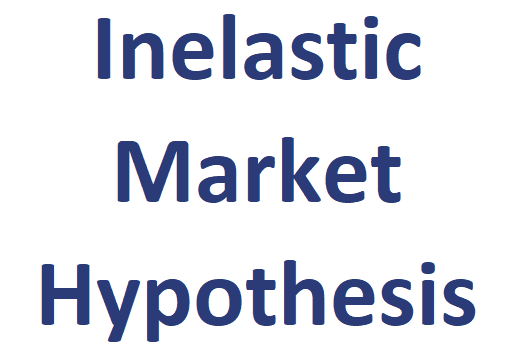Inelastic Market Hypothesis (IMH)
The inelastic market hypothesis is a very novel economic theory that tries to explain why financial markets are so volatile. The inelastic market hypothesis argues that the demand for financial assets, such as bonds or stocks, is relatively insensitive to changes in their prices. This conjecture implies that even if the price of an asset changes significantly, the demand for that asset may not change much as a result.
On this page, we discuss the intuition behind the Inelastic Market Hypothesis, the author of the concept as well as the implications for investors.
Inelastic Market Hypothesis Origin
The inelastic market hypothesis was proposed by Ralph Koijen and Xavier Gabaix in a working paper in 2020. In the paper, Koijen and Gabaix argue that the demand for financial assets is often driven by factors other than their price. In particular, most assets in equity markets are allocated by institutions, which are fairly constrained and cannot easily change their allocation because they have to maintain a fixed equity share. As a result, the price elasticity of the aggregate stock market is small and flows in and out of the stock market can have large impacts on prices.
According to the inelastic market hypothesis, the demand for financial assets is relatively inelastic in the short term, but may become more elastic over longer time horizons as investors have more time to adjust their portfolios. This means that the demand for an asset may be more sensitive to changes in its price over longer time periods, but relatively insensitive in the short term.
Inelastic Market Hypothesis Example
Let’s consider a simple example to see why high volatility is consistent with demand for stocks being insensitive to the price. Imagine a stock’s price drops significantly. If the demand for a stock is sensitive to the price, you would expect a lot of eager buyers picking up the stock. That demand would push up the price quickly so any drop in the price is short-lived and thus the volatility in the stock’s price would be quite low.
But that’s not the case in practice. Markets can be very volatile. During the pandemic, equity markets dropped 30% in a matter of weeks. One could argue that that was due to future growth prospects (‘fundamentals’) deteriorating quickly. But actually, it would take a very strong change in growth expectations to justify a change in fundamentals that is consistent with such a drop. This raises a number of questions.
First, why are markets inelastic? This is mainly the result of the fact that institutions that invest the money for investors cannot change their asset allocation. What that means is that most funds cannot change their proportions invested in stocks and bonds meaningfully even if market conditions change significantly. As a result, if somebody wants to buy stocks, there is not a lot of supply willing to sell their stocks as it will reduce their allocation. Only if the price increase is significant enough will funds be willing to sell.
Second, how big is the effect? It is estimated that a dollar of inflows into equities can increase the aggregate value of equity markets by $3-8.
Implications for investors
The inelastic market hypothesis has implications for investors and traders, as it suggests that the price of an asset may not always reflect its true value or the underlying fundamentals of the asset. It also suggests that market impact and transaction costs may play a larger role in the determination of asset prices in markets where demand is relatively inelastic.

